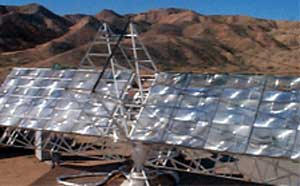The new 30 percent federal investment tax credit (effective next year)
will take the financial sting out of large investments in solar that might
otherwise be a riskier venture without it. And the companies making these
new commercial-scale investments are charting a new course for solar
energy in the U.S.
Traditional solar photovoltaic (PV) technologies, while well suited for
residential homes and businesses, are simply not the most efficient way to
address commercial solar-generated power. Although you might hear
differently from any company sending solar PV panels to Germany where the
government incentives are generous, the costly silicon raw material
required for PV modules is too precious and in too constrained a supply to
be used in large quantities for commercial power plants of multi-MW
capacities.
IAUS, like Stirling Energy Systems and Solargenix (see links below to
related stories) is pursuing the goal of large-scale solar-generated
commercial power through different means.
According to Chris Taylor, a staff engineer for IAUS, the company's CSP
power plant will have two fundamental characteristics that distinguish it
from regular solar PV technology and other solar approaches. First, it
will use a series of a hundred 30 foot-wide modules, each with a honeycomb
cluster of fresnel lenses -- effectively stacked pockets of polymer-based
magnifying glasses that capture the sun's energy to super-heat water to
1800 degrees F.
In a second stage, the super-heated water is kept pressurized at 3000 PSI
to prevent it from turning into steam. This water is then piped into a one
of IAUS' patented bladeless turbines -- almost like a fuel in a rocket
engine -- where it is released through a narrow nozzle that "flashes" the
water into steam that powers an electrical turbine.
Taylor says the company has developed an inexpensive way to manufacture
the polymer-based fresnel lenses and, when coupled with their unique
rocket-like turbines, the project is likely to eventually expand beyond
the initial 1 MW destined for outside Barstow, California.
And it's not just Taylor who feels optimistic about the approach. Power
Purchase Agreements (PPAs), a crucial element to a power project's
success, are already in the works with utilities in Nevada and Southern
California, Taylor told RenewableEnergyAccess.com. He could not say at
this time which utilities the company was establishing PPAs with.
IAUS expects to complete construction of the solar power plant during the
first quarter 2006. We'll be sure to keep you updated on this and other
unique CSP commercial solar applications as they progress.
